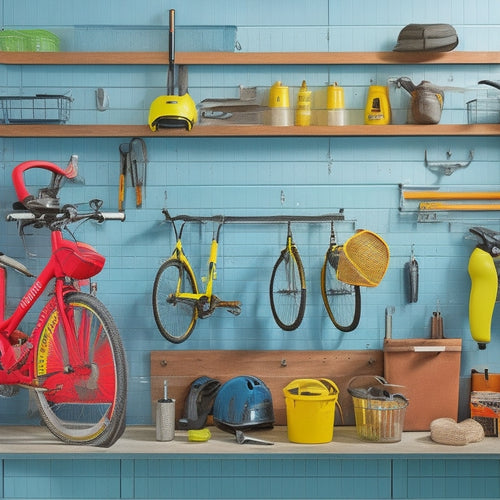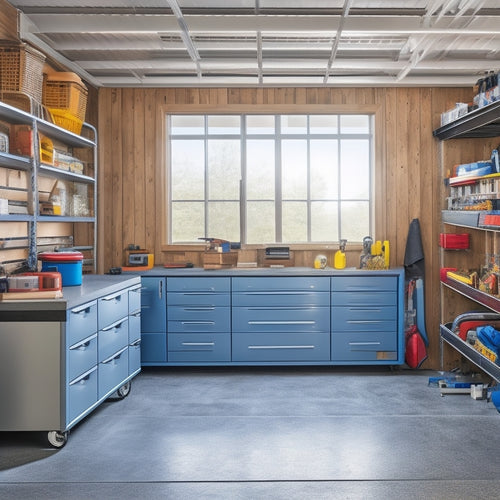
How to Build a Garage Fold Down Workbench in 7 Steps
Share
When building a garage fold-down workbench in 7 steps, you'll start by planning your workbench dimensions, considering factors like available space, comfort, and built-in storage. Next, prepare your wall mounting system, identifying anchor points and choosing hardware that can support at least four times the weight of a fully loaded workbench. Then, cut and assemble the workbench frame, attach the work surface panels, and install the folding mechanism hardware. Finally, mount and attach the work surface, testing the workbench's stability and weight capacity. As you follow these steps, you'll be well on your way to creating a sturdy, efficient, and safe workspace that's perfect for tackling any garage project - and that's just the beginning.
Key Takeaways
- Evaluate available garage space to determine optimal workbench dimensions, considering built-in storage and fixtures for enhanced safety and efficiency.
- Choose a wall mounting system that can hold at least four times the weight of a fully loaded workbench, ensuring secure installation and load distribution.
- Construct a sturdy frame using durable materials, precise cuts, and secure attachments to support the work surface and tools.
- Select a suitable folding mechanism that meets durability, weight capacity, and ease-of-use requirements, following manufacturer's instructions for installation.
- Test the workbench thoroughly, folding and unfolding multiple times, adding heavy objects, and verifying stability and structural integrity under load.
Plan Your Workbench Dimensions
Planning your workbench dimensions is essential to creating a functional and efficient workspace. You'll want to evaluate the space available in your garage, the type of projects you'll be working on, and the workbench materials you'll be using. A good rule of thumb is to plan for a workbench that's at least 30 inches deep and 60 inches wide. This will give you enough room to comfortably work on projects without feeling cramped.
When deciding on the height, assess your own comfort level and the type of tasks you'll be performing. A height of around 36 inches is usually ideal, but you may want to adjust this depending on your personal preference.
Don't forget to think about workspace organization, such as built-in storage for tools and supplies, and a vice or other fixtures that may affect the overall dimensions. By taking the time to plan your workbench dimensions carefully, you'll be able to create a safe and efficient workspace that meets your specific needs.
Prepare the Wall Mounting System
You'll need to identify the wall anchor points that can support the weight of your workbench and any tools or materials you plan to store on it.
Next, you'll choose the mounting hardware options that best fit your wall type and workbench design, such as lag screws, wall anchors, or molly bolts.
Make sure to select hardware that can hold at least four times the weight of your fully loaded workbench.
Wall Anchor Points
Your garage's wall is about to become a crucial part of your workbench's stability, so it's important to prepare a reliable wall mounting system. As you plan the wall anchor points, consider the load distribution and wall materials.
The type of wall anchor you choose will depend on the wall's composition, whether it's drywall, plywood, or concrete. For drywall or plywood walls, use anchors that spread the load across a larger area, such as molly bolts or toggle bolts. These will provide a secure hold without damaging the surrounding material.
For concrete walls, use anchors specifically designed for masonry, like sleeve anchors or wedge anchors. These will provide a strong hold and resist pull-out forces.
When selecting wall anchors, verify they're rated for the weight capacity of your workbench and any additional loads you plan to support. Always follow the manufacturer's instructions for installation and torque specifications to guarantee a safe and secure mounting system.
Mounting Hardware Options
With the wall anchor points selected, it's vital to choose the right mounting hardware to confirm a secure and level attachment of your workbench to the wall.
You'll need to select bracket types that suit your wall anchor points and workbench design. Consider weight capacity, verifying the brackets can support the weight of your workbench and any tools or materials you'll be using.
Hinge selection is also essential, as it will affect the fold-down mechanism's smoothness and durability.
When choosing brackets and hinges, prioritize material choices that offer durability and corrosion resistance. Stainless steel or heavy-duty aluminum are good options.
Cost considerations are important, but don't compromise on quality to save a few dollars. User safety depends on a sturdy and reliable mounting system.
During installation, follow the manufacturer's instructions carefully, and confirm the brackets are securely fastened to the wall anchor points.
Double-check the levelness of the workbench to prevent accidents.
Cut the Workbench Frame Components
What're the essential components that make up your garage workbench frame? You'll need four legs, two side aprons, two end aprons, and two top supports.
These components will provide the necessary frame stability to support your workbench materials and withstand the weight of your projects.
Using your miter saw or circular saw, cut the legs and aprons to the specified lengths according to your design plan.
Make certain to wear safety goggles and a dust mask to protect yourself from sawdust and debris. Cut the legs slightly taller than the desired height to allow for leveling feet.
For the top supports, cut two pieces to the same width as the workbench top.
These will provide additional support and prevent the workbench from sagging. Use a combination square to confirm the cuts are precise and accurate.
Double-check your measurements before cutting to avoid errors. With all the components cut, you're now ready to assemble the frame and legs.
Assemble the Frame and Legs
Assemble the Frame and Legs
You've cut the frame components; now it's time to assemble the frame and legs of your garage fold-down workbench. This step requires attention to design considerations and material selection to guarantee a sturdy and safe work surface.
Begin by assembling the legs, using 2.5-inch screws to attach the leg stretchers to the leg posts. Make sure the legs are square and the corners are secure.
Next, assemble the frame by attaching the side aprons to the leg posts using 2.5-inch screws. Confirm the frame is square and the corners are secure. Use clamps to hold the components in place while you screw them together. Use a level to verify the frame is level and plumb.
When assembling the frame and legs, keep in mind the weight capacity and material selection. You want a sturdy frame that can support the weight of your tools and materials.
Use high-quality materials and follow the design plan to guarantee a safe and functional workbench. Take your time, and double-check your work to avoid mistakes that can compromise the structural integrity of your workbench.
Attach the Work Surface Panels
You'll now attach the work surface panels to the frame, ensuring a sturdy and even surface for your garage workbench.
Before securing the panels, take a moment to prepare them by sanding the edges and applying a finish, if desired, to prevent splinters and improve durability.
Properly securing the panels is essential, so make sure to use the correct type and number of screws to prevent the panels from shifting or detaching over time.
Panel Preparation Tips
Two 3/4-inch thick work surface panels are the foundation of your garage workbench. When selecting panel materials, consider durability, resistance to moisture, and ease of cleaning. Medium-density fiberboard (MDF) or plywood are popular choices, but you may opt for a more premium material like solid hardwood or reclaimed wood.
Before attaching the panels, verify their surface finishes are suitable for your needs. A smooth, sanded finish is ideal for most applications, but you may prefer a textured or rough-hewn finish for a more rustic look. If you're using MDF, apply a coat of primer and paint to protect it from moisture and enhance its durability.
Inspect the panels for any defects, such as warping, cracks, or knots, and address them before proceeding. Sand the panels to remove any imperfections and create a uniform surface.
Secure Panels Properly
With the work surface panels prepared, it's time to secure them to the frame, creating a solid foundation for your garage workbench. Proper panel alignment is vital to guarantee the work surface is even and can withstand the intended load capacity. To achieve this, follow these steps:
| Step | Action |
|---|---|
| 1 | Place the panels on the frame, ensuring they're centered and evenly spaced. |
| 2 | Use clamps to hold the panels in place, applying even pressure to prevent warping. |
| 3 | Drill pilot holes for the screws, spaced 12 inches apart, to prevent the panels from splitting. |
| 4 | Screw the panels to the frame, using 2.5" wood screws, to create a solid bond. |
| 5 | Check the panels for level and plumb, making adjustments as necessary, to guarantee a safe and sturdy work surface. |
Remember to tighten the screws firmly, but avoid overtightening, which can damage the panels or frame. By following these steps, you'll create a secure and stable work surface that can handle the demands of your garage workshop.
Add the Folding Mechanism Hardware
As the workbench's frame takes shape, attention now turns to incorporating the folding mechanism hardware, an essential component that allows the workbench to change into a compact storage unit when not in use.
You'll need to choose from various folding mechanism types, including hinge-based, pivot-based, and slide-based systems. Each type has its advantages and disadvantages, so consider factors like durability, weight capacity, and ease of use before making a decision.
When installing the folding mechanism hardware, follow the manufacturer's instructions carefully. Typically, you'll need to attach the mechanism to the workbench frame using screws, bolts, or rivets.
Make certain the hardware is securely fastened to prevent accidents or injuries. Some installation tips to keep in mind include confirming the mechanism is properly aligned, using the correct type and amount of fasteners, and testing the folding action to guarantee smooth operation.
Additionally, consider adding safety features like soft-close mechanisms or safety latches to prevent the workbench from falling or collapsing unexpectedly.
Install and Test the Workbench
You've successfully attached the folding mechanism hardware to the workbench frame, guaranteeing a sturdy and reliable system.
Now it's time to install and test the workbench to confirm it meets your needs.
-
Mount the workbench to the wall: Securely attach the workbench to the wall using the wall anchors and screws provided. Make sure the workbench is level and plumb to guarantee stability.
-
Add the work surface: Place the work surface on top of the frame, ensuring it's properly aligned and securely attached.
-
Test the folding mechanism: Fold and unfold the workbench several times to verify the mechanism operates smoothly and reliably.
- Check the weight capacity: Test the workbench's weight capacity by placing heavy objects on it, gradually increasing the weight to confirm the workbench stability and structural integrity.
Remember to always follow safety guidelines when testing the workbench, and never exceed the recommended weight capacity.
Verify the workbench is stable and secure before using it for your projects.
Frequently Asked Questions
Can I Use a Pre-Made Work Surface Instead of Building One?
You can opt for pre-made work surface options, considering materials like butcher block, stainless steel, or laminate, which can save time and guarantee a sturdy base, but be sure to verify their durability and compatibility with your fold-down design.
How Do I Ensure the Workbench Is Level and Plumb?
"Measure twice, cut once" rings true when ensuring your workbench is level and plumb. You'll want to check your workbench materials for any warping or unevenness before using leveling techniques like shimming or adjusting the legs to guarantee a precise and safe working surface.
Are There Any Weight Capacity Limitations for This Design?
You'll need to evaluate weight capacity limitations, ensuring proper weight distribution across the design. Select materials that can handle the load, and calculate the maximum weight your fold-down workbench can safely support to prevent accidents and damage.
Can I Add Electrical Outlets or Lighting to the Workbench?
As you illuminate your workspace, you're wise to prioritize electrical safety. You can add outlets or lighting options, but guarantee you follow local codes, use GFCI outlets, and keep cords organized to avoid hazards, adding functionality without compromising your well-being.
Is It Possible to Make the Workbench Fold up Vertically Instead?
You can design a fold-up workbench that saves floor space by incorporating folding mechanisms, optimizing space with compact storage and ensuring stability with secure latches, ensuring a safe working area when folded up vertically.
Conclusion
You've built a garage fold-down workbench that's a beast of a workstation! With a sturdy frame, ample legroom, and a smooth folding mechanism, you'll be tackling projects like a pro in no time. You've saved precious floor space and gained a versatile work area that'll withstand years of heavy use. Now, go ahead and release your inner DIY expert on your next project - the possibilities are endless!
Related Posts
-

Maximum Capacity Tool Boxes for Heavy-Duty Use
You need a maximum capacity tool box that can withstand the rigors of heavy-duty use, protecting your essential tools...
-

Benefits of Pegboard Racks in Your Garage
By installing a pegboard rack in your garage, you'll reveal a wealth of benefits that change your workspace into a hi...
-

Top Rolling Tool Box Drawers for Maximum Storage
When it comes to maximizing storage with rolling tool box drawers, you need a solution that combines durability, cust...


